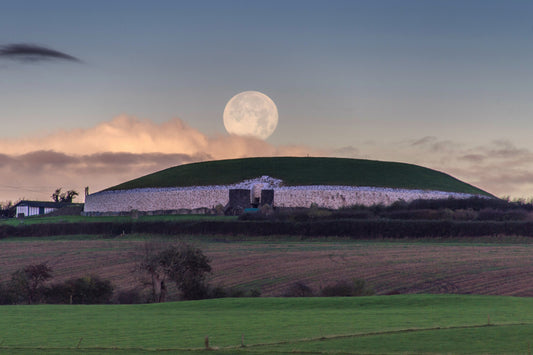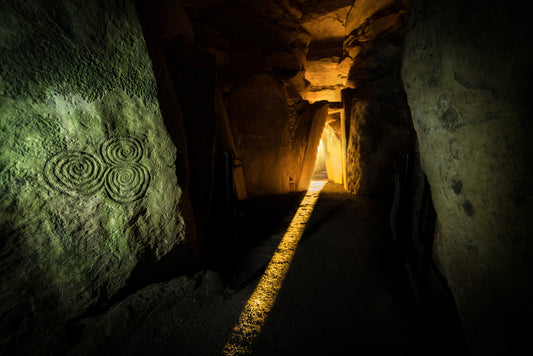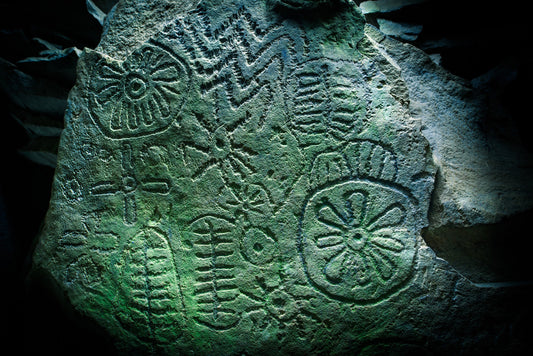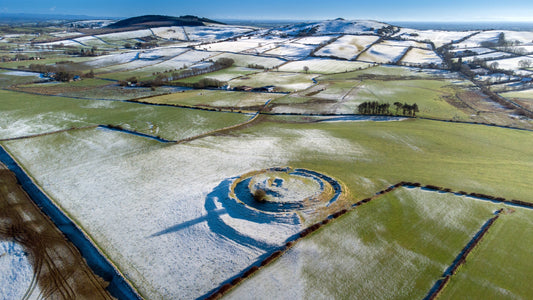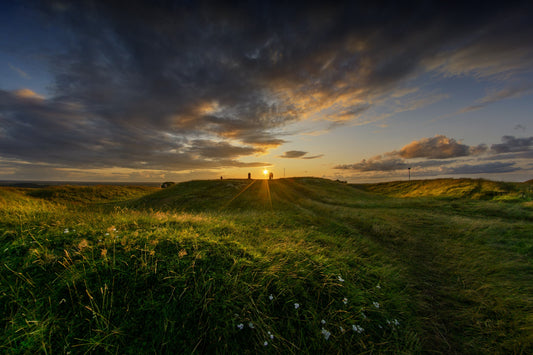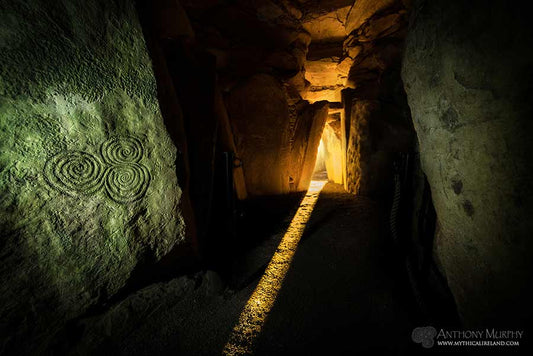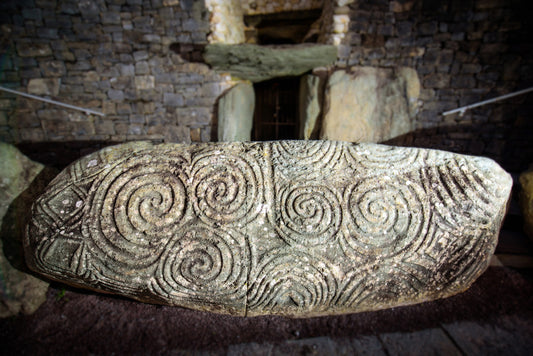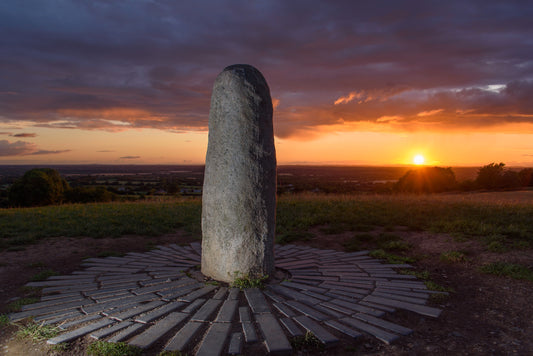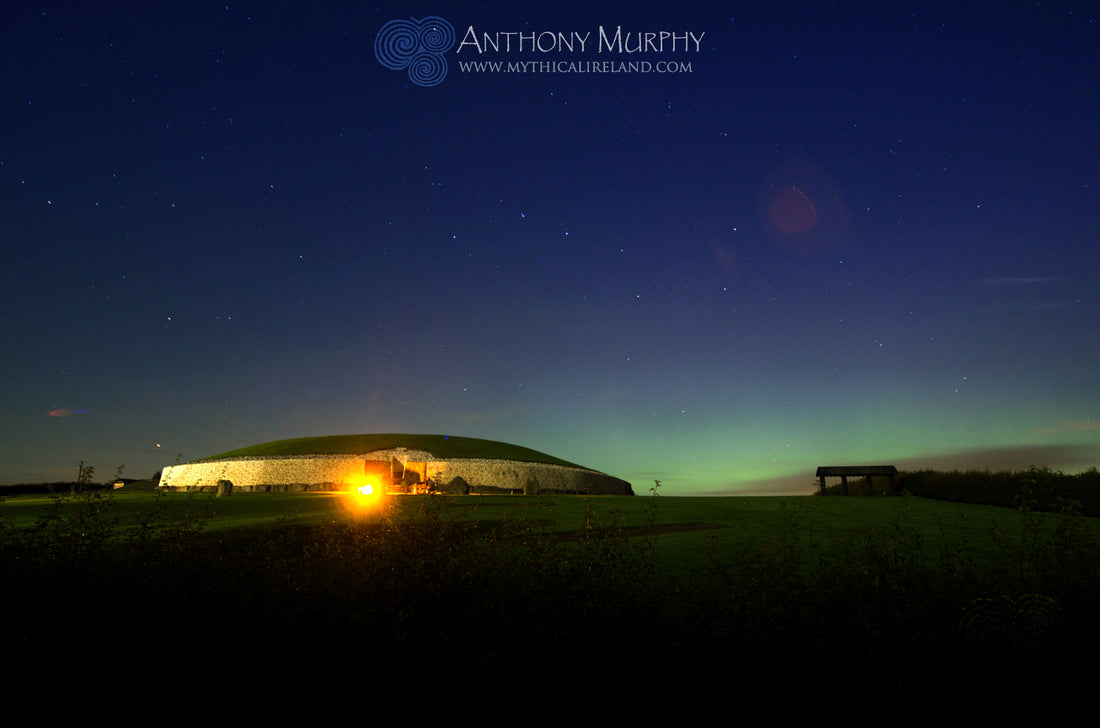
101 Facts about Newgrange
Newgrange, anciently called Síd in Broga and Brug Mac ind Óc, is Ireland's most famous prehistoric monument. It was built by a community of farmers and astronomers around 5,200 years ago. On this page, Anthony Murphy presents 101 facts about this fascinating and enigmatic remnant of Irish prehistory.
General Information
1. Newgrange is one of the best examples in Ireland and in Western Europe, of a type of monument known to archaeologists as a passage-grave or passage-tomb.
2. It was constructed around 3200BC, according to the most reliable Carbon 14 dates available from archaeology. This makes it more than 600 years older than the Giza Pyramids in Egypt, and 1,000 years more ancient than Stonehenge.
3. Newgrange was built in a time when there was only stone, not metal, used as an everyday material for tools and weapons. According to Clare O'Kelly, who assisted her husband Michael O'Kelly in the excavations of Newgrange, no metal has yet been found in a primary context in an Irish passage-grave.

4. Considerable damage was caused to the stones in the chamber of Newgrange in times past due to "evily-disposed visitors" who carved their names onto the stones. This graffiti can still be seen to this day.
5. More damage was done during the construction of nearby roads. Pownall said that large quantities of stones had been removed and the roads paved with them, and archaeologists found that the flat-topped mound had a number of hollows and craters as a result of the removal of stones.
6. In 1993, Newgrange and its sister sites Knowth and Dowth were designated a World Heritage Site by UNESCO because of their outstanding cultural legacy.
7. Newgrange was "rediscovered" in 1699. The landowner at the time, Charles Campbell, needed some stones and had instructed his labourers to carry some away from the cairn. It was at this time the entrance to the tomb was discovered.
8. Newgrange sits on the top of an elongated ridge within a large bend in the Boyne River about five miles west of the town of Drogheda. This area has great eminence thoughout Irish history - legend tells us the foundations of Christianity were laid here. Two miles or so downstream is Oldbridge, where the Battle of the Boyne took place in 1690.
9. Access to Newgrange is through the Brú na Bóinne Visitors' Centre at nearby Donore, just across the river Boyne. In recent times, there have been as many as 200,000 visitors to Newgrange each year, making it the most visited archaeological monument in Ireland.
10. The name "Newgrange", or New Grange, is relatively modern. The area around Newgrange was once part of the lands owned and farmed by the monks of Mellifont Abbey, and would have been known as a "grange".

Myths and Folklore
11. The Tuatha Dé Danann, who ruled Ireland in ancient mythology, were said to have erected Newgrange as a burial place for their chief, Dagda Mór, and his three sons. One of his sons, called Aonghus, is often referred to as Aonghus of the Brugh, and it was traditionally believed that he, in fact, was owner of the Brugh, and that a smaller mound between Newgrange and the Boyne was owned by the Dagda.
12. According to the Oxford Dictionary of Celtic Mythology, Newgrange (Brug na Bóinne) offered hospitality to countless guests in hundreds of stories.
13. Newgrange was said to have provided endless supplies of ale, three trees that were always in fruit, and two pigs, one of which was living, the other cooked and ready to eat.
14. The winter solstice event was known about in local folklore before the alignment was rediscovered by Professor Michael J. O'Kelly in 1967.
15. In some texts, Newgrange was said to have been the burial place of Lugh Lámhfada (Lugh of the Long Arm) who was the spiritual father of the great mythical hero Cúchulainn.
16. Newgrange was said to have been the mansion to which Aengus (Oengus) brought the body of Diarmaid after his death on Ben Bulben so that he could "put an aeriel life into him so that he will talk to me every day."
17. O'Grady's Silva Gadelica (1892) records that according to an ancient tradition, "three times fify sons of kings abode for three days with their three nights".
18. Newgrange was said to have been the place where the great mythical hero Cúchulainn was conceived by his mother Dechtine. His spiritual father, Lugh, visited Dechtine in a dream while she stayed at the Brugh.
19. The fact that Newgrange was referred to as "Mac an Og's brugh brilliant to approach", "yonder brugh chequered with the many lights" and "the white-topped brugh of the Boyne" has led some to believe these are references to the white quartz which adorns the cairn.
20. The romantic tale of Aonghus and Caer, who both flew to Newgrange and lived there in the form of swans, could be linked to the stars. Interestingly, Newgrange is a wintering ground for the Whooper Swan which migrates from Iceland every October and returns in March.

Construction of Newgrange
21. Newgrange mound should be properly referred to as a cairn, because it consists of water-rolled pebbles, each of which is between 6 to 9 inches across.
22. The entire mound contains an estimated 200,000 tonnes of material, and it has been estimated construction would have taken about 30 years using a workforce of about 300.
23. It is not known with any certainty how the larger stones which form the kerb and passage and chamber of Newgrange were brought to the site. Many of these stone slabs, 550 in number, were collected from where they had been lying in the landscape. Because many of the stones were found to be weathered, it is believed they were not quarried, so there would have been a huge logistical task in finding suitable boulders dotted throughout the landscape.
24. Because Newgrange sits atop a ridge, many of the large slabs would have needed to be brought uphill, again suggesting a highly organised community was behind its construction.
25. Michael J. O'Kelly, who excavated Newgrange, felt that the workforce involved in building Newgrange would have been divided up into about six gangs or teams, each with its own set of tasks and area of expertise.
26. There is no doubt that the people in charge of Newgrange's construction, from the master builder and architect down to the team foremen, were "intelligent and experienced", according to O'Kelly.
27. The passage and chamber orthostats would have been put in place before construction of the cairn itself actually began, and it is probable the kerb would have been marked out at this stage too.
28. The addition of grooves onto the top surface of the passage roof stones shows that the builders were aware of the need to redirect water seepage from the cairn, and therefore keep the passage water-proofed.
29. It is known that the white quartz, which was found on the ground in front of Newgrange during excavations, was not originally placed there by the builders. Some of the kerbstones which had fallen forward some time after the construction of the monument were found to be directly in contact with the subsoil, with no quartz beneath them.
30. Various estimates of the original height of Newgrange have been guessed at in recent centuries, with some explorers of the site giving estimates as high as 45.7 metres (150 feet). Archaeologists believe the actual height would not have been much more than 11 to 13 metres.

Passage and Chamber
31. The stone passage, chamber and corbelled roof of Newgrange, and the kerb of 97 stones, were constructed without the use of mortar.
32. The total length of the passage and chamber together is 24m (79ft), which means they only occupy one third the diameter of the mound.
33. In the passage, there are 22 orthostats or standing stones on the left (Western) side and 21 on the right (east). They have an average height of 1.5m, with the tallest stones nearer the chamber.
34. A total of 17 roof slabs can be seen covering the passage.
35. The large slab which can be seen pinned to the wall outside the passage mouth may have originally been used by the builders to block the passage when construction of the cairn was complete.
36. There are three separate chambers, or recesses, off the central chamber. The eastern chamber is the most impressively decorated, although all three contain decoration.
37. The corbelled roof of the chamber is one of the finest of its kind in Europe, and when Newgrange was excavated it was found to be standing intact without any repair work exactly as it had done when first built.
38. At one time, there was what was described as a "pyramidal-shaped" stone in the centre of the chamber. Some time after it was recorded by Thomas Molyneaux, it disappeared and has not been seen since.
39. All of the orthostats (standing stones) in the chamber are used to support the corbelled roof. Some have leaned inwards over time due to the weight of the cairn material pressing down on the chamber.
40. The tomb builders filled the gaps between the roof stones in the passage with sea sand and burned soil to keep the passage dry.

The Great Circle
41. There is some debate as to whether the so-called "Great Circle" was ever a complete circle at all. There are 12 surviving standing stones around the mound of Newgrange out of a possible original 35 to 38 orthostats.
42. One "pit" was found to the east of stone GC-2, which may have been a socket for one of the GC stones in former times. However, during later excavations a series of 70 pits were found in a giant arc to the east of the cairn, so it is not known if a standing stone ever stood at this location.
43. The Great Circle (GC) has an average diameter of 103.6m (340 ft), which is larger than the diameter of Stonehenge, the outer bank of which is 97.5m (320 ft).
44. The stones of the GC consist of greywacke, which is a type of sandstone, as well as limestone, granite and other igneous rocks and stand at a height of approximately 2 metres each.
45. Curiously, a number of the existing GC stones are diametrically opposite each other and many of the opposite pairs are spaced apart by 103.6 (340 feet) which is exactly 125 megalithic yards according to Alexander Thom.
46. Archaeoastronomer Frank Prendergast has produced data which shows that the "Great Circle" stones were astronomical and calendrical in function.
47. Excavations revealed that the Great Circle was erected some time after 2000BC, meaning it was the final stage of construction at Newgrange.
48. It is known that the Great Circle was erected when Newgrange was still in use. It had been put in place before the collapse of the cairn, which is obvious from the way the cairn slip material mounted up against the GC stones.
49. When Newgrange was being excavated, one of the GC stones, GC-10, was found lying prone, and was later re-erected in 1973 when archaeologists located its original socket.
50. An implement described by Professor Michael J. O'Kelly as an "iron wedge" was found under the turf near a pit which may have originally been a socket for stone GC-3. The archaeologists speculated this implement could have been used to split the stone - fragments of which may have been found nearby.

Kerb stones
51. Over time, cairn material slipped off Newgrange and buried the kerb stones, most of which remained totally hidden until excavations began in the 1960s.
52. The smallest kerb stone is 1.7m long, the largest 4.5m. The diameter of the kerb is between 79m (260ft) and 85m (280ft).
53. Most of the kerb stones are made of grit (grey-wacke) or slate, and according to the archaeologists they were collected rather than quarried.
54. According to archaeologists, the best edges of the kerb stones were placed at the top, while the bottom edges were put into sockets or supported above the ground so that an even top line was formed around the cairn.
55. This line is not horizontal all the way around the mound, however. The line of the kerb follows the contour of the ridge upon which Newgrange sits.
56. R.A.S. Macalister attempted to expose the entire kerb in 1928, when he and his workers began digging to the west of the entrance stone and continued until they had revealed 54 stones. At this point, the landowner objected and the work was halted!
57. The kerb was constructed in such a way as to curve inwards on either side of the entrance to the passage. This is a common feature which is found in many Irish passage-tombs.
58. Despite the often repeated prediction that the highly-decoratede kerbstone 52 marked an entrance to a possible second passage on the northwestern side of Newgrange, no such passage was found or indicated during archaeological work.
59. Some of the kerb stones were decorated before being put into place. Some stones were found with art on their rear, side and on the surface touching the ground. Other kerb stones, such as Kerb 1 and Kerb 52, were decorated in situ.
60. During excavations it was found that some kerbstones were not placed in sockets, but rather on top of a bed or layer of turves.

Satellite Sites
61. All of the so-called "satellite sites", the passage-mounds and standing stones in the vicinity of Newgrange, originally had their own names, according to the Dindshenchas. They included "The bed of Dagda", "the grave of Bóinn the wife of Nechtain", "The Valley of Mata" (the giant monster), and "the Mound of Bones".
62. One of the most unusual satellite sites located to the east of Newgrange is a large U-shapes "cursus", a type of monument believed to have served some grand ceremonial purpose. In recent years archaeology has found that a "ceremonial pathway" connected nearby passage-tombs to the cursus structure.
63. A survey of the whole area around Newgrange by Dr. Jon Patrick revealed some very interesting points: Newgrange and sites E, F and H are in a straight line. So also are Dowth and sites F, D and C. Patrick indicated that Newgrange was the focus of the groups of alignments which he found.
64. A total of 19 stones belonging to satellite sites near Newgrange contain decoration.
65. There are two standing stones located east-south-east of Newgrange, marked sites C and D on archaeological maps of the Bend of the Boyne.
66. A small mound located half a mile northeast of Newgrange called Site E has a number of kerbstones showing above the ground.
67. A substantially damaged mound lies within half a mile to the east of Newgrange. Part of an original kerb of stones is still extant at this site.
68. A mound in the field to the front of Newgrange was enclosed by a substantial embanked feature. This feature is still visible, although located in a tilled field where ploughing for agricultural use has made the ring difficult to see.
69. It is not known whether a figure-of-eight shaped pond feature south of Newgrange was originally a quarry from which stones were removed for its construction, or whether the unusual feature was some kind of "ceremonial pond".
70. A total of three satellite "passage-tombs" were excavated during archaeological work at Newgrange - sites K and L to the west and site Z to the east.

Finds and Artifacts
71. The bones of three dogs were found in the chamber of Newgrange during excavations, one each from the east and west chambers and one from just outside the end chamber. It is not known for sure whether these bones are ancient or more modern. It is thought they may have belonged to stray dogs who got into the passage but could not get out again.
72. A huge number of unburnt bone fragments were found by archaeologists. As well as large numbers of animal bones, there were approximately 750 unidentifiable fragments of bone. All of the human bones found were small fragments.
73. A large phallus-like stone was recovered from an oval-shaped stone setting which was found not far from the entrance of Newgrange.
74. Some cairn stones recovered during excavations were found to have decoration on them. One stone measuring 24.5cm wide had some parallel grooves, while others had U-shapes, groups of dots and spiral-cum-concentric circle patterns.
75. Gold objects have been found at Newgrange, including two ancient gold torques (torcs), a golden chain and two rings, which were discovered by a labourer digging near the entrance in the 1840s. The hoard became known as the Conyngham Find, and is now in the British Museum.
76. One type of find which arouses the interest of archaeologists are the Roman coins, many of which were reported to have been found at Newgrange. The first recorded find of a Roman coin was in 1699, and coins were still being found as late as the 1960s when Newgrange was being excavated. These included some gold coins and pendants, and some were found to be in mint condition. A total of 21 Roman coins have been found.
77. A number of pendants and beads were found, something which is common to Irish passage-graves in general.
78 Among the stone marbles which were recovered was a dumb-bell shaped object which resembled two conjoined marbles carved out of a single piece of white chalk.
79. A 'chisel' made from bone was found in the east recess, and was similar to one which had been found in the chamber of Site L, one of the satellite mounds beside Newgrange.
80. An object thought to be a 'stone lamp' resembled a ball-shaped object which was flattened on opposite sides. The object was made from granite.

Megalithic Art
81. Archaeologists categorise the range of motifs which make up the decoration on the stones of Newgrange. These categories are: circles, spirals, arcs, serpentiforms, dot-in-circles, zigzags (chevrons), lozenges, radials or star shapes, parallel lines, and offsets or comb-devices.
82. Of all the categories of motif, the most common at Newgrange are lozenge and zigzag (chevron). The lozenge is most prominent in the interior of the site.
83. In his study of "Megalithic Art in Ireland", Muiris O'Sullivan points out that by decorating the convex surface of the entrance kerbstone, Kerb 1, with a "curvilinear" arrangement, the artist has managed to make the stone look "considerably more massive" than it actually is.
84. Despite the presence of some of the most beautifully and intricately designed kerbstones (e.g. K1 and KI52), the kerb art at Newgrange does not match that of Knowth in terms of volume and overall grandeur.
85. The majority of decorated passage-mounds, accounting for more than four-fifths of the decorated stones, are located in Co. Meath, including Newgrange.
86. About seven-tenths of the kerbstones uncovered during archaeological work at Newgrange are decorated with megalithic art.
87. The famous so-called "triple spiral" on a standing stone in the central recess of the chamber actually consists of a total of six spirals.
88. Despite an apparent lack of megalithic art on some of the passage orthostats, every one of these stones features a style of decoration which archaeologists call "pick-dressing". On stones which feature other types of art, the pick-dressing tends to overlap onto the existing art.
89. An arragement of spirals, lozenges and zigzags on a passage orthostat (L19) has been interpreted by many people as representing a face, possibly a god or deity of some kind.
90. Curiously, some of the megalithic art at Newgrange was found on the reverse side of some of the kerbstones and chamber stones - in locations where they could not be seen.

Astronomy of Newgrange
91. On the Winter Solstice, the light of the rising sun enters the roofbox at Newgrange and penetrates the passage, shining onto the floor of the inner chamber. The sunbeam illuminates the chamber of Newgrange for just 17 minutes.
92. It is believed by some researchers that the colour of the sunrise on the morning of Winter Solstice was the original inspiration for the name of the hill over which that sunrise occurs when viewed from Newgrange. The hill is called Red Mountain.
93. It has been suggested by Robert Lomas and Christopher Knight that Venus would have been visible inside the chamber of Newgrange at certain times during its eight-year cycle.
94. It is an astronomical fact that at certain times during its 19-year cycle, the Moon shares the same declination, and therefore the same rising azimuth, as the midwinter sunrise. Therefore, there are times during the Moon's cycle when it too would be visible inside Newgrange.
95. Newgrange and Dowth are situated such that at moonrise at the time of minor standstill north, the Moon comes up over Dowth viewed from Newgrange. At minor standstill south, the Moon sets over Newgrange viewed from Dowth. Martin Brennan suggests a similar minor standstill orientation for Newgrange and Knowth.
96. A survey of the roofbox, passage and chamber of Newgrange by Dr. Jon Patrick in 1972 found that the Winter Solstice orientation of the site was an original feature, and that they were sophisticated constructions, intended to maximize the accuracy and length of the beam entering the chamber.
97. A further study by Tim O'Brien showed that at the time of construction the sun-beam was so accurately framed by the roof-box aperture that Newgrange could be used to determine the exact day of solstice.
98. While sunrise on Winter Solstice takes place over a hill across the Boyne river called "Red Mountain", sunset takes place over a hill in the distance called Realtoge, which means "star" or "young star" and which has a large ringfort on its summit.
99. Newgrange is known as a brugh (or brú), which is often translated as meaning a "mansion". However, there is an old Irish word - Brú - which means "womb". Could Brú na Bóinne mean "womb of the bright cow" or "womb of the Moon"? Many researchers have pointed out the layout of the entrance, passage and chamber of Newgrange has a resemblance to the female reproductive organs.
100. Frank Prendergast's research demonstrated how the shadow of GC1, the megalith adjacent to the entrance, would have crossed the lower part of the three spirals on the west side of K1 at the winter solstice; that the shadow of GC-1 would have crossed through the centre of the three spirals at the period when the south declination of the sun was half its annual maximum; that the shadow of stone GC-2 similarly crosses the same three spirals at the equinox.

Fact 101
101. An interesting one to finish on. I saw this on another website, and found it very intriguing to say the least. This is what happens when you take a picture of kerbstone 1, the famous entrance stone at Newgrange, and mirror it. Different people see different things. Personally, I agree with those who can see the female reproductive system, which makes sense in light of the fact that Brú means "womb". However, some people even see a face. What do you see?

